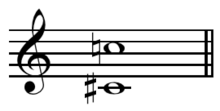Diminished octave
In classical music from Western culture, a diminished octave (![]()

Diminished octave on C 
| Inverse | Augmented unison |
|---|---|
| Name | |
| Other names | Diminished eighth |
| Abbreviation | d8[1] |
| Size | |
| Semitones | 11 |
| Interval class | 1 |
| Just interval | 48:25, 256:135[2], 4096:2187 |
| Cents | |
| Equal temperament | 1100[2] |
| Just intonation | 1129, 1108[2], 1086 |

Diminished octave on C-sharp 
The diminished octave is enharmonically equivalent to the major seventh.
Sources
- Benward & Saker (2003). Music: In Theory and Practice, Vol. I, p.54. ISBN 978-0-07-294262-0. Specific example of an d8 not given but general example of perfect intervals described.
- Duffin, Ross W. (2008). How equal temperament ruined harmony : (and why you should care) (First published as a Norton paperback. ed.). New York: W. W. Norton. p. 163. ISBN 978-0-393-33420-3. Retrieved 28 June 2017.
- Benward & Saker (2003), p.92.
gollark: I guess. I can install hyperfine quickly.
gollark: Given the factor-of-7 difference in runtime I am forced to assume that they are wrong.
gollark: I just ctrl+F-ed it. They do not explain how they were running the TypeScript.
gollark: "Scripting language" or not isn't actually rigidly defined or significant.
gollark: Guessing things about performance *always* works!
This article is issued from Wikipedia. The text is licensed under Creative Commons - Attribution - Sharealike. Additional terms may apply for the media files.